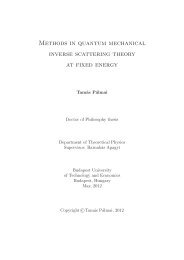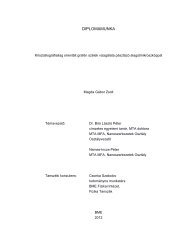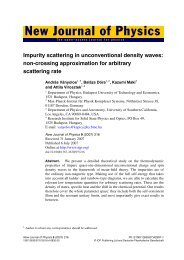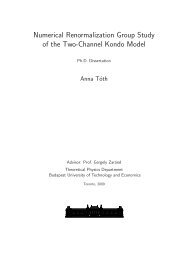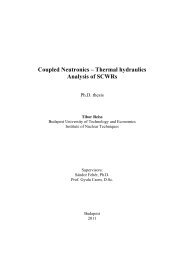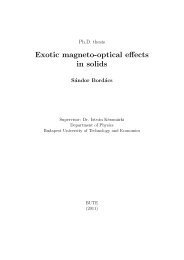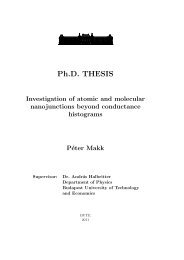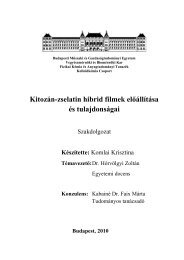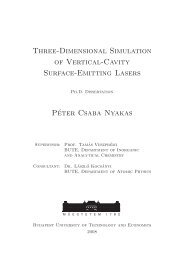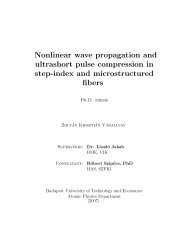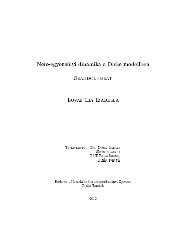Ph.D. THESIS Multipolar ordering in f-electron systems
Ph.D. THESIS Multipolar ordering in f-electron systems
Ph.D. THESIS Multipolar ordering in f-electron systems
You also want an ePaper? Increase the reach of your titles
YUMPU automatically turns print PDFs into web optimized ePapers that Google loves.
Chapter 2 Overview of the Theoretical Background 19<br />
of k<strong>in</strong>etic exchange, superexchange, and RKKY <strong>in</strong>teraction can be generalized<br />
to <strong>in</strong>clude multipolar <strong>in</strong>teractions. It follows that multipolar coupl<strong>in</strong>gs<br />
are not necessarily weaker than dipolar coupl<strong>in</strong>gs. A microscopic study of<br />
Ce-Ce <strong>in</strong>teractions gave the result that octupolar, quadrupolar and dipolar<br />
coupl<strong>in</strong>gs are of the same order of magnitude [6]. On the experimental side,<br />
it is known that quadrupolar <strong>order<strong>in</strong>g</strong> happens before magnetic <strong>order<strong>in</strong>g</strong> <strong>in</strong><br />
many Ce, Tm and Pr compounds. We will discuss <strong>in</strong> detail the case of NpO 2<br />
<strong>in</strong> which octupolar <strong>order<strong>in</strong>g</strong> is the lead<strong>in</strong>g <strong>in</strong>stability <strong>in</strong> Chapter 3.<br />
We are go<strong>in</strong>g to discuss which form of <strong>in</strong>ter-site <strong>in</strong>teractions is allowed<br />
by symmetry considerations. The local order parameters are the multipoles<br />
whose s<strong>in</strong>gle-site symmetry classification for cubic environment was shown<br />
<strong>in</strong> Table 2.3. The most general form of the <strong>in</strong>teraction Hamiltonian between<br />
lattice sites i and j is<br />
H ij =<br />
3∑<br />
k,l=1<br />
7∑<br />
+<br />
k,l=1<br />
J kl<br />
ij (m)J k i J l j +<br />
5∑<br />
k,l=1<br />
J kl<br />
ij (Q)Q k i Q l j<br />
J kl<br />
ij (O)O k i O l j + . . . (2.25)<br />
where Ji k , Q k i and Oi k are the dipolar, quadrupolar and octupolar momentum<br />
components at a site i. Jij kl (m), Jij kl (Q) and Jij kl (O) are the magnetic,<br />
quadrupolar and octupolar coupl<strong>in</strong>g constants, respectively 12 .<br />
The lattice Hamiltonian is<br />
H <strong>in</strong>t = ∑ ij<br />
H ij (2.26)<br />
the sum of all pair <strong>in</strong>teractions.<br />
H <strong>in</strong>t is <strong>in</strong>variant under the symmetry operations of the lattice. Each term<br />
of multipoles with different orders <strong>in</strong> Hamiltonian (2.26) must be an <strong>in</strong>variant<br />
(basis element for the identity representation of the symmetry group of the<br />
lattice). This gives a str<strong>in</strong>gent restriction for the form of (2.26).<br />
In the absence of external magnetic field, time reversal is an additional<br />
symmetry. This is manifest <strong>in</strong> the form of (2.25) <strong>in</strong> which odd (even) multipoles<br />
are coupled with only odd (even) multipoles 13 .<br />
While H <strong>in</strong>t has the full symmetry of the lattice, the pair <strong>in</strong>teraction H ij<br />
has only the symmetry of a two-site cluster (atoms i and j), which is a lower<br />
symmetry. For <strong>in</strong>stance, even <strong>in</strong> a cubic system, the pair <strong>in</strong>teractions have<br />
12 We th<strong>in</strong>k the effects of the conduction <strong>electron</strong>s <strong>in</strong>cluded <strong>in</strong>to these coupl<strong>in</strong>g constants.<br />
13 This would, <strong>in</strong> pr<strong>in</strong>ciple, allow dipole-octupole <strong>in</strong>teraction which we did not <strong>in</strong>clude<br />
<strong>in</strong> Hamiltonian (2.25).



